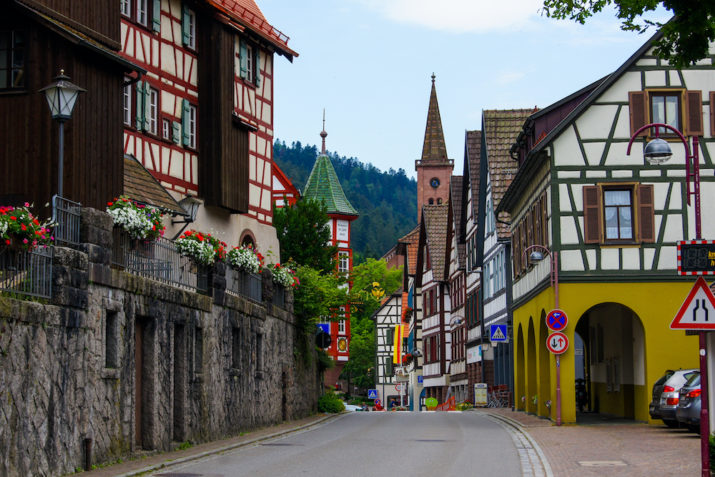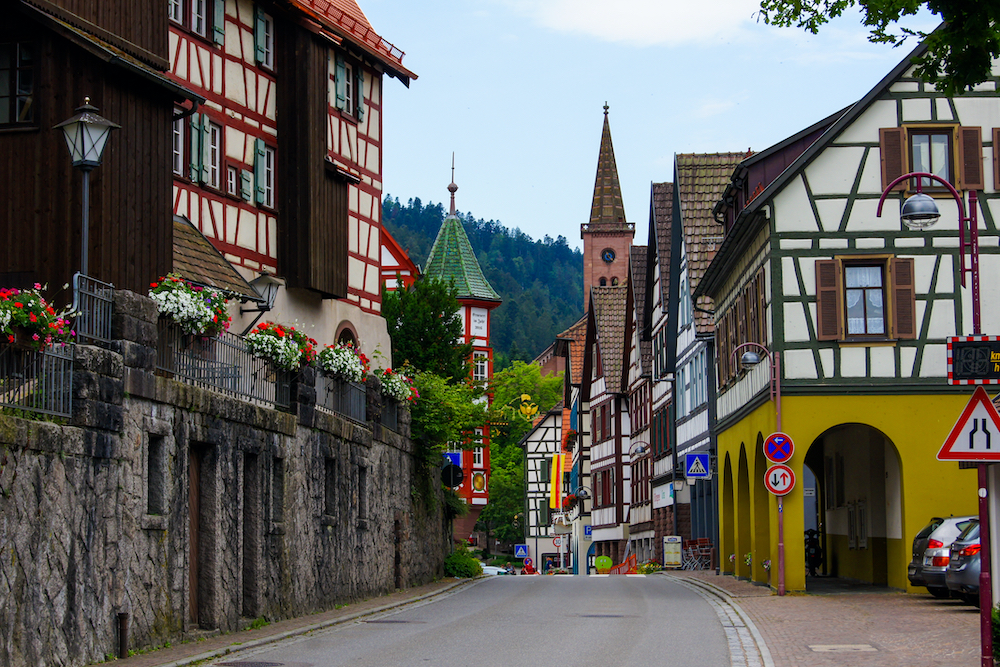

This is part of our special feature on Rurality in Europe.
This story begins shortly after the Second World War and covers the tremendous changes, both economically and socially, that the rural areas of Germany have undergone since then. At the same time, this paper recounts the history of a unique research project: starting in 1952, ten villages from western Germany, characterized by small-scale family-farming and heterogeneous enough to represent the diverse regional conditions in Germany at that time, were selected for an intensive analysis. Although it was not initially intended, the study came to be repeated in subsequent decades. The very same villages were analyzed in 1972 and again in 1993.[1] In 2012, the hitherto last “wave” of the project, which was by then titled[2] “Changing rural living conditions 1952, 1972, 1993 and 2012” started at the Thünen-Institute of Rural Studies—and I was lucky to be a PhD-candidate in this special project.
After the war, the country saw an influx of refugees from the east and lost important agricultural areas. In consequence, more people had to be fed off of fewer and less productive agricultural plots. While agriculture in the eastern parts of the country was dominated by large estates, in western Germany agriculture was predominantly small-scale and run with family members’ labor. Therefore, intensification and professionalization became the mantra of the era, only to be replaced through “consolidation” and a cut to subsidies to combat overproduction in the 1960s-1980s period. Processes that had already originated before the war, such as demographic changes and outmigration from rural areas, accelerated again in the post-war period, due to the difficult conditions. For example, working days on small family-farms were long, and some villages still faced high infant mortality and did not even have electricity or a sewage system for every household (Becker 1997).
To mitigate this situation and to know more about the very heterogeneous conditions “on the ground” and across the different rural areas of western Germany, the Ministry of Agriculture and a newly founded research society for Agricultural Policy and Rural Sociology set up a research project covering ten villages from western Germany. This project was funded through the Marshall fund. Besides western Germany, Italy, the Netherlands, Belgium, and France also received considerable US technical aid to expand their research capacities in rural development and rural sociology (Lowe 2010). In these countries, social problems were particularly pressing due to the large number of small family farms paired with a rather low level of mechanization (ibid.). Not only did the structure of agriculture call for action, but so did the history of rural sociology in Germany. Under the fascist regime, rural sociology had become a vehicle for the inhumane race and settlement policies that were used to legitimize the annexation of foreign territory during the Second World War (Becker 2005). Thus, US (rural) sociology had a certain influence on the development of methods and perspectives in European rural sociology at the time (Lowe 2010), as would become visible in the project under focus here, in the ways in which it relied on a strong empirical base and research questions that were focused on the daily life of rural people.
The ten selected villages represented a cross-over of areas with lagging development and difficult conditions, predominantly caused by the given natural and landscape factors of the area. One village, for example, was located in the marsh area of the northwest, bordering the Netherlands, while another village was located in the mountain areas of the Eifel, bordering Belgium. Both regions had very unfavorable conditions for agriculture. They were remote from any large urban agglomerations, and infrastructures, such as access to the autobahn, were missing. The farms in these two villages were so small that they could barely sustain the families living on the grounds—the threshold to subsistence at that time being around eight hectares. In contrast, other villages in the south and southwest of Germany were included in the project for their relatively favorable agricultural conditions that made vineyards and family-farming profitable.
Twelve universities (predominantly departments of agriculture) and research institutes came together and conducted fieldwork in accordance to a comprehensive data collection scheme. One research assistant was assigned to each village and he or she was to live there for an entire year. Although not mentioned explicitly in the data-collection manual, the researchers applied a bundle of ethnographic methods to their subject. They focused on the farming population and followed them through their daily work throughout the year. The field reports entail meticulous lists of nutrition and household items, but also recount the sharing of work among the family members and the social fabric holding the family together.
1952 reports: in-depth ethnographies of rural hardship
The concluding reports of the 1952 wave give a wide-framed picture of the vast regional differences between rural areas in western Germany. Some reports leave us with a somewhat burdensome description of poverty, hard physical labor, lack of education, and a lack of technological progress in farming equipment. This is, however, not true for all the villages and we have to remember that the villages were indeed chosen because of their difficult situation. Furthermore, the 1952 reports are characterized by a perspective on rurality that addresses not only the self-evident “backwardness” of rural areas, but also partly that of the population, in a spirit of “modernization.” The reports, and the study they were based on, were designed to make very practical and applicable suggestions for improvements, covering even moral and intellectual “improvements” for the inhabitants. Thus, that series of reports documents well the changing relations between rural and urban, between science and policy-making, and of course between social scientists and their research “subjects.” Through our meta- or discourse analysis of the four final research reports in this study (Tuitjer and Steinführer 2019), we can show how the researchers’ view on the inhabitants of the villages has changed dramatically since the 1950s. In line with developments in sociology, ethnography, and rural studies, villagers are no longer seen as merely the recipients of development aid. Rather, their role in endogenous development is now acknowledged and ways to support and multiply their efforts are sought after.
1973 reports: standardization and statistics reveal diminishing disparities
Twenty years later, in 1973, living conditions in rural areas had changed tremendously. The country had gone from food shortage to Butterberge—mountains of butter—due to subsidized overproduction. It was primarily the massive changes in agriculture that prompted the Ministry of Agriculture to finance another wave of research in the same ten villages. This time, the methods were characterized by standardization and statistical procedures. Instead of detailed reports for each village, household surveys with the farming population (in addition to some non-farming households) were conducted. An area of particular interest was to detect differences between farming and non-farming households regarding socio-economic status. Measured, for example, were educational attainment, household structures (two- or three-generation households, or the number of children), and material standard of living―such as the availability of a car, a freezer, or other household appliances. Although consolidation of agriculture had progressed in most of the regions under focus and the share of people working on a farm had already diminished, farming households were still the point of reference. Regional differences, however, were no longer of interest, and the report focused on a potential rural/urban divide instead. Already, differences between urban and rural lifestyles and living conditions had dropped remarkably.
1990s: household surveys in the re-unified Germany point to new lines of regional disparity
The third wave, finally, was triggered by the fundamental changes occurring in Germany and Europe as a whole with the fall of the Iron Curtain. After reunification, four villages from the eastern parts of Germany were added to the project. While the selection criteria in the 1950s had been meant to sample small scale family-farming villages with either good or difficult economic conditions, these additional four villages were picked based on their location in relation to urban agglomerations and road access. Among these four villages was a Sorb village. The Sorbs (along with the Wends) are an ethnic and linguistic minority in the mid-east of Germany who speak a Slavic language, similar to Czech. Following the trajectory of the 1970s study, the focus on the farming population loosened further and instead a further household survey was conducted in each village.
Certainly, reunification, with its massive economic and social consequences for the people in eastern Germany, left a strong mark on this wave. The results from this survey show a rather clear-cut divide between rural living conditions in eastern and western German. While western villages predominantly profited from a phase of growth and population influx through “counter urbanization” (a short phase were the growth of the cities came to a halt and people moved to rural areas close to urban centers), the eastern German villages experienced unemployment and economic hardships, as well as outmigration and social change. Already during the time of the German Democratic Republic, the rural areas in the north-east in particular had lost some of their population, as many people migrated to the newly industrialized (smaller) cities. In some villages, modern tenement houses had been built to retain the inhabitants and attract new ones from even smaller villages, but this worked only very partially (Becker 1997).
The 1993 report on the third wave of the “Changing rural living conditions” project entailed an entire section dedicated to the perceptions of rural living and rural social relations. The report asked how rural people experienced the social fabric of their home places, and which role neighborhood, community and interpersonal solidarity played. Importantly, the author of the report did not assume any genuinely “rural” social mechanism, such as for example trustful communities or extensive patterns of neighborly help. Rather, it acknowledged the place-specificity of social relations, pointing out that individualization characterized both urban and rural social relations alike.
2012 report and beyond: does the “rural” still exist?
By the time of the project’s last wave in the 2010s, rural living had received new media attention. Public debate was torn between a focus on “dying” villages experiencing population loss and lacking infrastructure and social services, and an idealization of a “slow” and stress-free rural lifestyle (Baumann 2016). Likewise, concerns about an ageing population and loss or lack of services adjusted to its needs fueled public debate and research interest (Steinführer et al. 2014) —this debate has continuously gained momentum to this day, and equal living conditions across the country are at the fore of policy intervention and media coverage today.
In 2012 again, six universities came together to developed a data-collection scheme and a new research framework for the project. While in the 1950s it had set out to ameliorate the partly appalling living conditions in some rural places to prevent social unrest, in 2012 the project asked whether uniquely rural living conditions did exist anymore. Due to changes in methods and theory, the project’s 2012 wave partly applied social constructivist perceptions on the “doing” of rurality. New research topics that were part of the project reflected the changing perceptions of rurality. Only one report pertained to agriculture, asking local people about their views of agriculture. Findings showed that the consolidation of agriculture in particular had changed the appearance of the villages and their inhabitants’ lifestyle. The fraction of the population working in agriculture had diminished, while the estates had grown larger and more specialized. While in the 1950s the share of farmers varied between 14 percent to 85 percent of the local population in the ten villages under study, in the 2012 survey none had more than fifteen farms left. Other reports covered themes such as childhood in rural area, daily living arrangements, housing conditions and housing preferences, gender relations, local policy making and Internet and new media use. Overall, the studies were interested in the patterns of daily life and revealed a varied picture of regional living conditions and lifestyles. Given the small scale of our analysis (a village or a group of villages), it is difficult to draw any further conclusions from the data.
Recent works of the Thünen-Institute of Rural Studies, a research unit of the Federal Ministry of Food and Agricultural, show that in today’s Germany, about two thirds of the population live outside large cities, which was not the case at the beginning of the twentieth century when that rate was about 20 percent. However, today less people live in villages and an increasing number of people live in small and mid-sized towns of 5,000 to 100,000 inhabitants (Steinführer 2020). As is the case throughout Europe, demographic changes in Germany and an aging and shrinking population are overarching processes influencing the development of rural areas, as well as the relation between rural and urban areas. In general, today, people grow older and fertility rates are below the replacement rate (2.1 children per woman). Large cities are growing further, while scarcely populated areas keep losing population. It is young people and immigrants in particular who primarily move to urban areas. However, on the regional level these processes can differ tremendously, with adjacent communities experiencing opposite developments, driven by individual factors, such as attractive housing or landscape, or good connection to public transport. More recent influx of refugees from the Middle East and Africa in 2015-2016 created a momentary population increase and some rural communities (as well as urban communities) made great efforts to offer a new home to refugees (Schammann et al. 2020; Meschter 2020). In particular, efforts of volunteers to integrate refugees into their rural communities have been comprehensive, including language courses, but also support in meeting with German authorities, etc. (Hamann and Karakayali 2016). However, immigrants in search of jobs and cultural communities still tend to settle in urban areas.
Recently, and in parts driven by the experiences with refugees and the Willkommenskultur practiced by some, the current public discourse about rural areas has been concerned with rural people allegedly “feeling left behind” and with “equal living conditions.” The rise of a new fascist party (Alternative für Deutschland, AfD) and the search for an explanation for this rise have led many to assume that people in rural areas feel like they are second class citizens or have been left behind (Deppisch 2019). Indeed, the geographical voting pattern for the AfD-Party does not follow a simple urban-rural divide but differs for eastern and western Germany (Deppisch et al. 2019). Seen from the outside, Germany is a country with ubiquitous access to social services and healthcare, good infrastructures, and a high standard of living. However, equality in living conditions remainsa vague normative guideline in spatial planning (Steinführer et al. 2020) is currently repeatedly called into question in the public discourse. Indeed, there seems to be at least “perceived disparities between cities and the countryside” (Klaeren 2020). Infrastructures, such as road conditions, sewer systems, and the availability of general practitioners are especially recurrent issues. However, there is little empirical evidence to back up significant disparities in living conditions between rural and urban areas.
Although agriculture and extraction of raw materials such as soft coal and rare earths are found more often in rural than urban places and shape the visible character of some rural areas, these activities are only of marginal importance both to employment and added value in a predominantly tertiary economy (Küpper 2020). Germany is characterized by considerably large regional socio-economic differences, but these describe the relations between eastern and western Germany and between the “agrarian” north and the “industrialized” south of the country. For example, differences in disposable income vary primarily between eastern and western Germany. Within the last twenty years, disposable income in rural areas caught up so that in 2014 there was no longer a significant difference between urban and rural counties. Regarding life expectancy, some areas with the lowest expectancy and the smallest increase within the last ten years are located both throughout eastern German and the highly urbanized Ruhr Area (the German “rust belt” characterized by mining and steel processing)—again regional differences dominate over rural-urban disparities (Küpper and Peters 2019).
As recent research shows (Margarian 2018), rural and urban areas in the east and west of Germany are still developing differently. While a catching up of eastern urban centers has been facilitated by the influx of highly qualified (young) professionals, rural industrial areas in eastern Germany have had little prospect to prosper on their own. The overall standard of living has increased tremendously since the 1950s throughout the country and especially in rural areas. At the same time however, the heterogeneity that characterized rural living conditions in the 1952 project is still present and regional differences remain over structural differences between settlement types.
Gesine Tuitjer is a researcher at Thünen Institute of Rural Studies, Germany. Her areas of work cover Rural Development, Rural Gender Studies, and Entrepreneurship and Innovation.
References:
Baumann, Christoph. 2016. Die Lust am Ländlichen – Zur Persistenz und Variation idyllischer Ländlichkeit. Informationen zur Raumentwicklung 249–259.
Becker, Heinrich. 1997. Dörfer heute: Ländliche Lebensverhältnisse im Wandel; 1952, 1972 und 1993/95 (Bonn: Forschungsgesellschaft für Agrarpolitk und Agrarsoziologie).
Becker, Heinrich. 2005. NS-Agrarideologie und -soziologie. In Stephan Beetz, K. Brauer, and Claudia Neu (eds.): Handwörterbuch zur Ländlichen Gesellschaft in Deutschland. (Wiesbaden: VHS), 210–217.
Deppisch, Larissa, Andreas Klärner, and Torsten Osigus. 2019. Ist die AfD in ländlichen Räumen besonders erfolgreich? Wissen Schafft Demokratie 74–87. Available at: https://www.idz-jena.de/wsddet/wsd5-10/
Deppisch, Larissa. 2019. „Wo sich Menschen auf dem Land abgehängt
fühlen, hat der Populismus freie Bahn“ – eine Analyse des populär-medialen Diskurses zu
der Bedeutung von Infrastrukturverfall, Abstiegsangst und rechten (extremistischen) Werten für den Zuspruch zum Rechtspopulismus. Thünen Working Paper 119, Braunschweig, Germany. Available at: http://doi.org/10.3220/WP1550668971000
Hamann, Ulrike., and Karakayali, Serhat. 2016. Practicing Willkommenskultur: Migration and Solidarity in Germany. Intersections 2. Available at: https://intersections.tk.mta.hu/index.php/intersections/article/view/296
Klaeren, Jutta. 2020. Editorial. Ländliche Räume, 3. Available at: https://www.bpb.de/shop/zeitschriften/informationen-zur-politischen-bildung/312730/laendliche-raeume
Küpper, Patrick. 2020. Was sind eigentlich ländliche Räume? Ländliche Räume, 4–7. Available at: https://www.bpb.de/shop/zeitschriften/informationen-zur-politischen-bildung/312730/laendliche-raeume
Küpper, Patrick, and Jan Cornelius Peters. 2019. Entwicklung regionaler Disparitäten hinsichtlich Wirtschaftskraft, sozialer Lage sowie Daseinsvorsorge und Infrastruktur in Deutschland und seinen ländlichen Räumen (Johann Heinrich von Thünen-Institut). Available at: http://doi.org/10.3220/REP1547565802000
Lowe, Patrick. 2010. Enacting Rural Sociology: Or what are the Creativity Claims of the Engaged Sciences?: Enacting rural sociology. Sociologia Ruralis 50:311–330.
Margarian, Anne. 2018. Strukturwandel in der Wissensökonomie: Eine Analyse von Branchen-, Lage- und Regionseffekten in Deutschland (Johann Heinrich von Thünen-Institut). Available at: http://doi.org/10.3220/REP1537461545000
Meschter, Diana. 2020. Auf dem Dorf hast du einen Namen, in der Stadt eine Nummer – Geflüchtete in ländlichen Räumen. Kurzdosier Bundeszentrale für politische Bildung. Available at: https://www.bpb.de/gesellschaft/migration/kurzdossiers/308032/gefluechtete-in-laendlichen-raeumen
Schammann, Hannes, Younso, Christin, and Diana Meschter. 2020. Lokale Migrationspolitik in ländlichen Regionen Deutschlands: Ausgangspunkte für empirische Forschung (Johann Heinrich von Thünen-Institut). Availabe at: http://doi.org/10.3220/WP1585900191000
Steinführer, Annett. 2020. Dörfer und Kleinstädte im Wandel. In Ländliche Räume, 8–15. Available at: https://www.bpb.de/shop/zeitschriften/informationen-zur-politischen-bildung/312730/laendliche-raeume
Steinführer, Annett, Patrick Küpper, and Alexandra Tautz.2014. Adapt and Cope: Strategies for safeguarding the quality of life in a shrinking ageing region. Comparative Population Studies 39: 345–370.
Steinführer, Annett, Christian Hundt, Patrick Küpper, Anne Margarian, and Peter Mehl: Gleichwertigkeit der Lebensverhältnisse – wissenschaftliche Verständnisse und Zugänge. Ländlicher Raum 3/2020:12-19.
Tuitjer, Gesine, and Annett Steinführer. 2019. The scientific construction of the village. Framing and practicing rural research in a trend study in Germany, 1952–2015. Journal of Rural Studies. DOI: 10.1016/j.jrurstud.2019.12.006.
[1] Since 1952, a tremendous amount of material was collected covering the ten, later fourteen villages. Each time, the project was conducted by a consortium of different universities and research centers, with updated methods and research questions. Please refer to Tuitjer & Steinführer for a detailed description of the institutional aspects of the project.
This article is based on earlier work that was published in the Journal of Rural Studies (Tuitjer and Steinführer 2019).
Photo: Beautiful view of ancient half-timbered village houses at the narrow main street of the village of Schiltach, Germany
Published on November 10, 2020.




